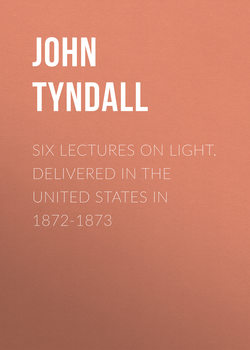Six Lectures on Light. Delivered In The United States In 1872-1873

Реклама. ООО «ЛитРес», ИНН: 7719571260.
Оглавление
John Tyndall. Six Lectures on Light. Delivered In The United States In 1872-1873
PREFACE TO THE FOURTH EDITION
ON LIGHT
LECTURE I
§ 1. Introduction
§ 2. Subject of the Course. Source of Light employed
§ 3. Rectilineal Propagation of Light. Elementary Experiments. Law of Reflection
§ 4. The Refraction of Light. Total Reflection
§ 5. Velocity of Light. Aberration. Principle of least Action
§ 6. Descartes' Explanation of the Rainbow
§ 7. Analysis and Synthesis of Light. Doctrine of Colours
§ 8. Colours of Pigments as distinguished from Colours of Light
LECTURE II
§ 1. Origin and Scope of Physical Theories
§ 2. The Emission Theory of Light
§ 3. The Undulatory Theory of Light
§ 4. Wave-Motion, Interference of Waves, 'Whirlpool Rapids' of Niagara
§ 5. Analogies of Sound and Light
§ 6. Interference of Light
§ 7. Colours of thin Films. Observations of Boyle and Hooke
§ 8. Newton's Rings. Relation of Colour to Thickness of Film
§ 9. Theory of 'Fits' applied to Newton's Rings
§ 10. The Diffraction of Light
§ 11. Application of the Wave-theory to the Phenomena of Diffraction
LECTURE III
§ 1. Derivation of Theoretic Conceptions from Experience
§ 2. Theory of Crystallization
§ 3. Ordinary Refraction of Light explained by the Wave Theory
§ 4. Double Refraction of Light explained by the Wave Theory
§ 4. Double Refraction of Light explained by the Wave Theory
§ 5. Polarization of Light explained by the Wave Theory
LECTURE IV
§ 1. Action of Crystals on Polarized Light: the Nicol Prism
§ 2. Colours of Films of Selenite in Polarized Light
§ 3. Colours of Crystals in Polarized Light explained by the Undulatory Theory
§ 4. Colours produced by Strain and Pressure
§ 5. Colours of Unannealed Glass
§ 6. Circular Polarization
§ 7. Complementary Colours of Bi-refracting Spar in Circularly Polarized Light. Proof that Yellow and Blue are Complementary
§ 8. The Magnetization of Light
§ 9. Iris-rings surrounding the Axes of Crystals
§ 10. Power of the Wave Theory
§ 11. The Blue of the Sky
§ 12. Artificial Sky
§ 13. Polarization of Skylight
LECTURE V
§ 1. Range of Vision and of Radiation
§ 2. Ultra-violet Rays: Fluorescence
§ 3. The Heat of the Electric Beam. Ignition through a Lens of Ice. Possible Cometary Temperature
§ 4. Combustion of a Diamond by Radiant Heat
§ 5. Ultra-red Rays: Calorescence
§ 6. Identity of Light and Radiant Heat. Reflection from Plane and Curved Surfaces. Total Reflection of Heat
§ 7. Invisible Images formed by Radiant Heat
§ 8. Polarization of Heat
§ 9. Double Refraction of Heat
§ 10. Magnetization of Heat
§ 11. Distribution of Heat in the Electric Spectrum
LECTURE VI
SUMMARY AND CONCLUSION
APPENDIX. ON THE SPECTRA OF POLARIZED LIGHT
MEASUREMENT OF THE WAVES OF LIGHT
Отрывок из книги
USES OF EXPERIMENT
EARLY SCIENTIFIC NOTIONS
.....
In all cases where the light is incident from air upon the surface of a solid or a liquid, or, to speak more generally, when the incidence is from a less highly refracting to a more highly refracting medium, the reflection is partial. In this case the most powerfully reflecting substances either transmit or absorb a portion of the incident light. At a perpendicular incidence water reflects only 18 rays out of every 1,000; glass reflects only 25 rays, while mercury reflects 666 When the rays strike the surface obliquely the reflection is augmented. At an incidence of 40°, for example, water reflects 22 rays, at 60° it reflects 65 rays, at 80° 333 rays; while at an incidence of 89½°, where the light almost grazes the surface, it reflects 721 rays out of every 1,000. Thus, as the obliquity increases, the reflection from water approaches, and finally quite overtakes, the perpendicular reflection from mercury; but at no incidence, however great, when the incidence is from air, is the reflection from water, mercury, or any other substance, total.
Still, total reflection may occur, and with a view to understanding its subsequent application in the Nicol's prism, it is necessary to state when it occurs. This leads me to the enunciation of a principle which underlies all optical phenomena—the principle of reversibility.5 In the case of refraction, for instance, when the ray passes obliquely from air into water, it is bent towards the perpendicular; when it passes from water to air, it is bent from the perpendicular, and accurately reverses its course. Thus in fig. 5, if m E n be the track of a ray in passing from air into water, n E m will be its track in passing from water into air. Let us push this principle to its consequences. Supposing the light, instead of being incident along m E or m′ E, were incident as close as possible along C E (fig. 6); suppose, in other words, that it just grazes the surface before entering the water. After refraction it will pursue say the course E n″. Conversely, if the light start from n″, and be incident at E, it will, on escaping into the air, just graze the surface of the water. The question now arises, what will occur supposing the ray from the water to follow the course n‴ E, which lies beyond n″ E? The answer is, it will not quit the water at all, but will be totally reflected (along E x). At the under surface of the water, moreover, the law is just the same as at its upper surface, the angle of incidence (D E n‴) being equal to the angle of reflection (D E x).
.....